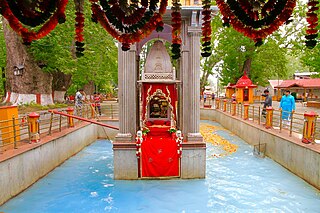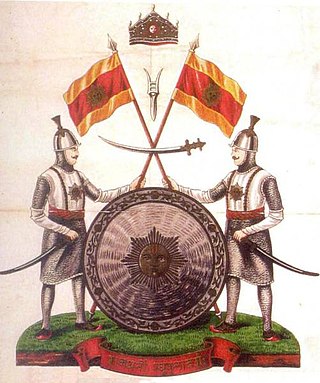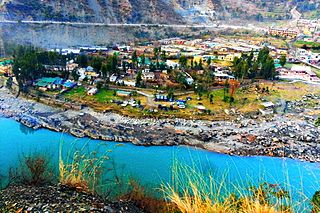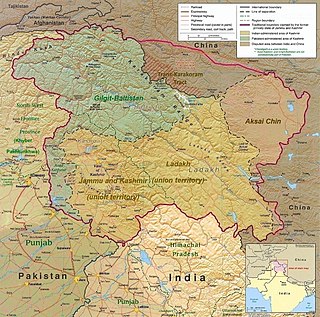Related Research Articles

Udhampur (ˌʊd̪ʱəmpur) is a city and a municipal council in Udhampur district in the Indian union territory of Jammu and Kashmir. It is the headquarters of Udhampur District. Named after Raja Udham Singh, it serves as the district capital and the Northern Command headquarters of the Indian Army. A Forward Base Support Unit (FBSU) of the Indian Air Force is also stationed here. Udhampur is used by the Armed Forces as a transit point between Jammu and Srinagar when travelling by road on National Highway 1A, which has since been renamed as National Highway 44.
The Dogras or Dogra people, are an Indo-Aryan ethno-linguistic group living primarily in the Indian union territory of Jammu and Kashmir and neighbouring Pakistan, consisting of the Dogri language speakers. They live predominantly in the Jammu region of Jammu and Kashmir, and in adjoining areas of Punjab and Himachal Pradesh. Some also live in northeastern Pakistan. Their historical homeland is known as Duggar.

Raghunath Temple is a Hindu temple located in Jammu in the Indian union territory of Jammu and Kashmir. It consists of a complex of seven Hindu shrines. Raghunath Temple was constructed by the first Dogra ruler Maharaja Gulab Singh in the year 1835 and later his son Maharaja Ranbir Singh got it completed in the year 1860 During Dogra rule. The temple has many gods in its complex of shrines, but the presiding deity is Rama – also known as Raghunath, an Avatar of Vishnu. All the spiral-shaped towers have gold plated spires. The niches in the walls of the shrines are decorated with 300 well-crafted icons of gods and goddesses including those of Surya and Shiva, but most are particularly related to the life stories of Rama and Krishna. The paintings in the 15 panels of the main shrine are based on themes from Ramayana, Mahabharata, and Bhagavad Gita. The temple premises include a school and a library that preserves over 6,000 manuscripts in many Indian languages, with a notable collection of Sarada script Sanskrit manuscripts.

Maharaja Gulab Singh Jamwal (1792–1857) was the founder of Dogra dynasty and the first Maharaja of the princely state of Jammu and Kashmir, which was a part of Panjab and Sikh Empire became the largest princely state under the British Raj, which was created after the defeat of the Sikh Empire in the First Anglo-Sikh War. During the war, Gulab Singh would later side with the British and end up becoming the Prime Minister of Sikh Empire. The Treaty of Amritsar (1846) formalised the transfer of all the lands in Kashmir that were ceded to them by the Sikhs by the Treaty of Lahore.
Ranbir Singh Pora is a town and nagar panchayat, near city of Jammu in Jammu district of the Indian Union territory of Jammu and Kashmir. It was the first planned city of Jammu and Kashmir

Bhimber is a town and the headquarters of the eponymous district in Pakistan-administered Azad Kashmir. The town and district are between the Jammu region of Indian-administered Kashmir and Pakistan proper, about 47 km (29 mi) by road southeast of Mirpur.

Ranbir Singh was Maharaja of Jammu and Kashmir from 1856 until his death in 1885.

Sir Pratap Singh was the Maharaja of Jammu and Kashmir, and head of the Jamwal Rajput clan.

Kheer Bhawani,Ksheer Bhawani or the Ragnya Devi temple is a Hindu temple situated at a distance of 25 kilometres (16 mi) north-east of Srinagar, Jammu and Kashmir, India, in the village of Tulmul in Ganderbal. It is dedicated to the Hindu goddess Kheer Bhavani constructed over a sacred spring. As is the custom with Hindu deities, the goddess has many names including Ragnya or Rajna, along with variations in honorifics such as Devi, Mata or Bhagavati. The term kheer refers to a milk and rice pudding that is offered to propitiate the goddess. Kheer Bhawani is sometimes translated as 'Milk Goddess'. The worship of Kheer Bhawani is universal among the Hindus of Kashmir, most of them who worship her as their protective patron deity Kuladevi.

Jamwal is a toponymic surname for a Dogra Rajput clan of the same name from Jammu, in Jammu and Kashmir, India. They claim descent from the traditional founder of Jammu, Jambu Lochan, and there at one time some of their members were rulers of the princely state of Jammu and Kashmir, often referred to as the Dogra dynasty.

Ramban is a town in Ramban district of Jammu and Kashmir, India, which is the district headquarters of Ramban district. It lies on the banks of the Chenab river in Chenab Valley on the National Highway-1A at about 120 km from Jammu and about 130 km from Srinagar, making it almost the central point on the Jammu-Srinagar National Highway.

The Dogra dynasty of Dogra Rajputs from the Shivalik hills created Jammu and Kashmir when all dynastic kingdoms in India were being absorbed by the East India Company. Events led the Sikh Empire to recognise Jammu as a vassal state in 1820, and later the British added Kashmir to Jammu with the Treaty of Amritsar in 1846. The founder of the dynasty, Gulab Singh, was an influential noble in the court of the Sikh emperor Maharaja Ranjit Singh, while his brother Dhian Singh served as the prime minister of the Sikh Empire. Appointed by Ranjit Singh as the hereditary Raja of the Jammu principality, Gulab Singh established his supremacy over all the hill states surrounding the Kashmir Valley. After the First Anglo-Sikh War in 1846, under the terms of the Treaty of Lahore, 1846, the British Indian government acquired Kashmir from the Sikh Empire and transferred it to Gulab Singh, recognising him as an independent maharaja. Thus, Jammu and Kashmir was established as one of the largest princely states in British India, receiving a 21-gun salute for its Maharaja in 1921. It was ruled by Gulab Singh and his descendants till 1947.

Poonch District was a district of the princely state of Jammu and Kashmir, which is currently divided between India and Pakistan. The Pakistani part of the erstwhile district is now the Poonch Division in the Azad Kashmir territory, whilst the Indian part of the district is the Poonch district in Jammu and Kashmir. The capital of the Pakistan-controlled side is Rawalakot; while the capital of the Indian-controlled side is Poonch.

Jammu and Kashmir is home to several valleys such as the Kashmir Valley, Chenab Valley, Sindh Valley and Lidder Valley. Some major tourist attractions in Jammu and Kashmir are Srinagar, with its renowned Dal Lake and Mughal Gardens, Gulmarg, Pahalgam, Bhaderwah, Patnitop and Jammu. Every year, thousands of Hindu pilgrims visit holy shrines of Vaishno Devi and Amarnath which has had a significant impact on the state's economy.

The history of Azad Kashmir, a disputed part of the Kashmir region currently administered by Pakistan, is related to the history of the Kashmir region during the Dogra rule. Azad Kashmir borders the Pakistani provinces of Punjab and Khyber Pakhtunkhwa to the south and west respectively, Gilgit–Baltistan to the north, and the Indian union territory of Jammu and Kashmir to the east.The region is claimed by India as a part of the Jammu and Kashmir union territory and addressed as PoK( Pakistan-occupied Kashmir).

The Jammu division is a revenue and administrative division of the Indian-administered Jammu and Kashmir in the disputed Kashmir region. It is bordered by the Kashmir division to the north. It consists of the districts of Jammu, Doda, Kathua, Ramban, Reasi, Kishtwar, Poonch, Rajouri, Udhampur and Samba. Most of the land is hilly or mountainous, including the Pir Panjal Range which separates it from the Kashmir Valley and part of the Great Himalayas in the eastern districts of Doda and Kishtwar. Its principal river is the Chenab.

Jammu is a city in Indian-administered Jammu and Kashmir in the disputed Kashmir region. It is the winter capital of Jammu and Kashmir, which is an Indian-administered union territory. It is the headquarters and the largest city in Jammu district. Lying on the banks of the river Tawi, the city of Jammu, with an area of 240 km2 (93 sq mi), is surrounded by the Himalayas in the north and the northern plains in the south. Jammu is the second-most populous city of the union territory. Jammu is known as "City of Temples" for its ancient temples and Hindu shrines.

Vaishno Devi Temple, also known as the Shri Mata Vaishno Devi Temple and Vaishno Devi Bhavan, is a Hindu mandir (temple) located in Katra, Jammu and Kashmir, dedicated to Vaishno Devi, a manifestation of Durga. It is located on the Trikuta mountain at 5,000 feet elevation. The Shakti tradition considers it to be a Shakti Pitha. The temple is governed by the Shri Mata Vaishno Devi Shrine Board (SMVDSB) and has been chaired by the Governor of Jammu and Kashmir since August 1986.
Raghunath Temple, Srinagar is a Hindu temple located in Srinagar in the union territory of Jammu and Kashmir. Construction started under Maharaja Gulab Singh in 1835 and was completed in 1860 by Maharaja Ranbir Singh. The temple was attacked and later abandoned following the exodus of Kashmiri Hindus from Kashmir valley. The abandoned temple is being restored.
References
- ↑ Pintchman, Tracy (2001). "1". Seeking Mahadevi: Constructing the Identities of the Hindu Great Goddess. State University of New York (SUNY) Press. pp. 57, 67. ISBN 978-0-7914-9049-5.
- ↑ Rai 2004, p. 114.
- ↑ Rai 2004, p. 119.
- 1 2 Badhwar, Inderjit (31 March 1987). "Take-over of Vaishno Devi shrine by independent board erupts into legal controversy". India Today. Retrieved 28 January 2022.
- ↑ "Home page, introduction". Dharmarth Trust, Jammu/Srinagar, official website. Archived from the original on 24 September 2010.
- 1 2 "Dharmarth Trust awaits govt instructions to open shrines". Tribune India. 10 June 2020. Archived from the original on 15 June 2020. Retrieved 28 January 2022.
- ↑ Singh 1974, p. 9, 197, 198.
- ↑ Singh, Bawa Satinder (1971). "Raja Gulab Singh's Role in the First Anglo-Sikh War" . Modern Asian Studies. 5 (1): 36. doi:10.1017/S0026749X00002845. ISSN 0026-749X. JSTOR 311654. S2CID 145500298.
- 1 2 3 4 Rai 2004, p. 116.
- ↑ Rai 2004, p. 115-116.
- 1 2 Rai 2004, p. 117.
- 1 2 3 Rai 2004, p. 118.
- ↑ Zutshi, Chitralekha (2004). Languages of Belonging: Islam, Regional Identity, and the Making of Kashmir. Hurst. pp. 48, 49. ISBN 978-1-85065-700-2.
- ↑ Chauhan, Abha (2011). "4. Sacred Landscape and Pilgrimage: a study of Mata Vaishno Devi". In Singh, Rana P. B. (ed.). Holy Places & Pilgrimages: Essays on India. New Delhi: Shubhi Publications. pp. 105–126. ISBN 978-81-8290-228-2.
- ↑ "Temples of Dharmarth Trust". Hinduism Today. 1 April 1992. Retrieved 5 February 2022.
- ↑ "Temples under Dharmarth Trust will get face-lift under Smart City project: Mayor". State Times . 29 October 2021. Retrieved 28 January 2022.